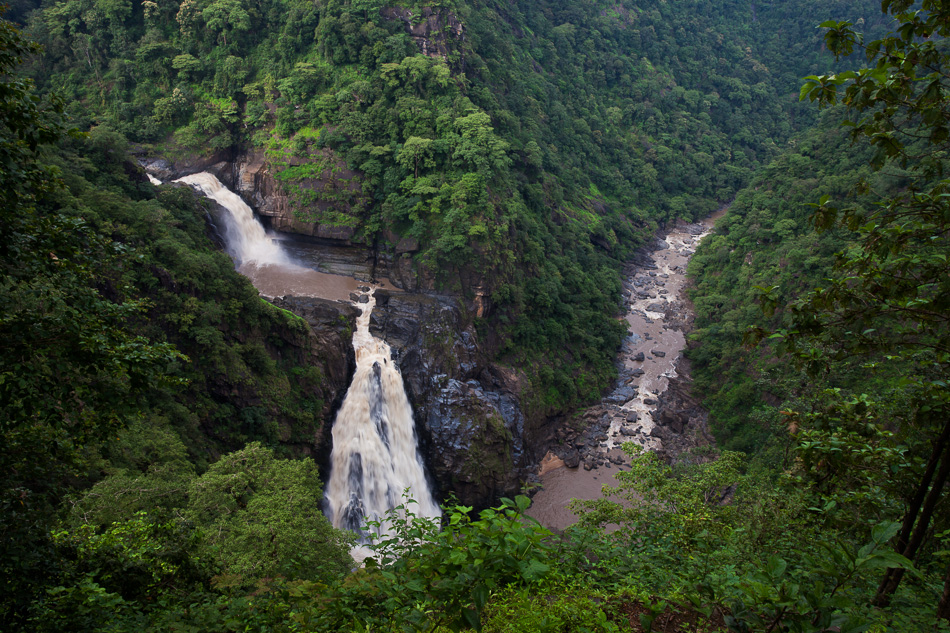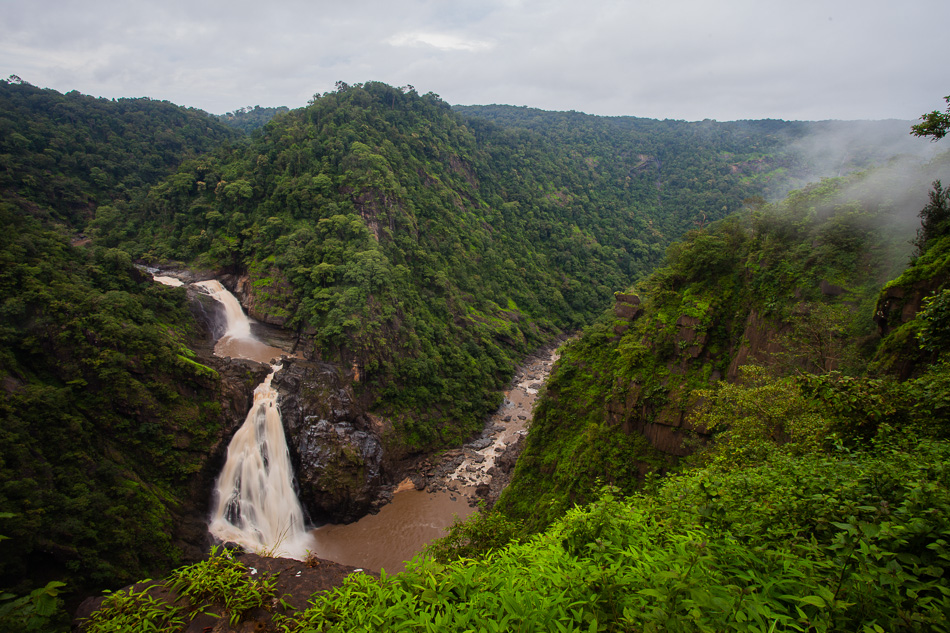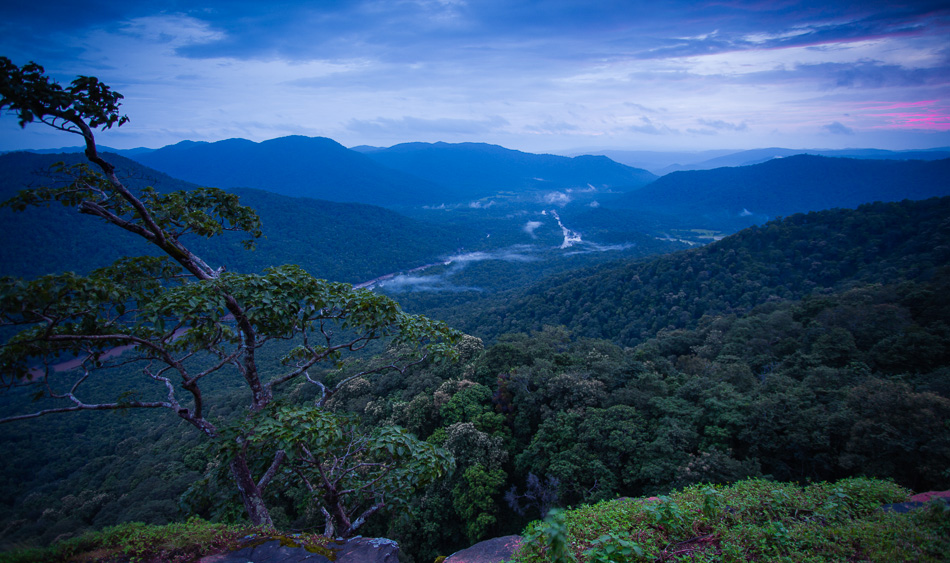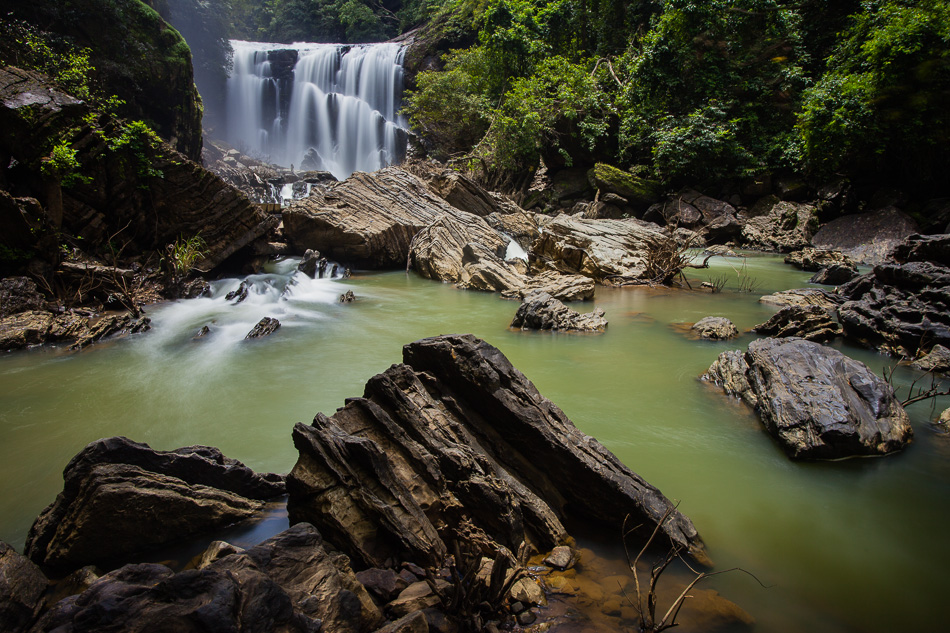Waterfalls in the Sahyadris: Unchalli, Magod and Satoddi
Some of the finest and most beautiful waterfalls in the country are well off the mainstream travel itineraries. They may not be the largest in volume, tallest in fall or the most well-known. And yet, they are easily among the prettiest waterfalls I have ever seen.
Magod Falls, Unchalli Falls, Satoddi Falls. Have you heard of these waterfalls? The answer is likely to depend on how far you live from these places, how active a traveller are you and how intrepid are your journeys.
Brilliant view of Magod Falls dropping into a deep valley.
If India for you is a diamond shaped country somewhere between middle east and [South-East] Asia, chances are you only know about Taj Mahal in the entire country. If you live somewhere within India and your idea of travelling is the yearly holiday to a luxury resort, chances are that you may have heard about a Jog Falls here and a few others around your city, no more. If you live within Karnataka, there is some chance that you may have heard a passing mention unless you are a frequent traveller. But for those who jump at the first opportunity to explore, especially in Karnataka, these places are either in the must-do list or they have already been ticked.
I have heard from a countless number of my travel-buff friends about Satoddi falls and Magod falls. Everyone of them has unfailingly mentioned not only about the size and height of these falls, but the dramatic location in which they are set. Often so dramatic that I wouldn’t be easily convinced.
Consider Magod falls for example. I was told time and again that it is nearly impossible to get to the base of the waterfall, and you have to be satisfied with the [incredible] views of the fall from a platform on the opposing hill. Why not, I would think, there must always be a way around to the base of the valley. All that one needs to do is to look hard for a way to get down. It could perhaps be long and circuitous way but I could not imagine why it should be impossible. But when I heard this from multiple quarters, especially from friends whose words I was willing to accept, I had to go and check it out.
I kept planning a visit for years. In the past half decade, I have been travelling across the country like the world is going to end tomorrow, but somehow never managed to set aside two days to visit Magod Falls and its surroundings. Year after year, I talked myself into visiting the hills in the monsoons when the waterfalls are in their roaring best. But year after year, I ended up spending much of the monsoon months in the mountains of north, high in the Himalayas admiring the snow peaks and driving up and down its majestic valleys.
The mahoortha came this year, finally. A proposal came from an old travel companion and a good friend that we should go. Convention says that impromptu decisions are the ones that tend to get executed when it comes to travelling. Since it hadn’t worked for me with these waterfalls, I set a date two months in advance and decided to stick to it. The stars approved the dates. My ever-busy weekends remained free on the set dates. And my good friend was able to stick to the plan despite expecting a baby, as his daughter came to the world a couple of weeks earlier than expected.
We set out on a weekend when the monsoons had just begun to subside (early September), but the flow in the rivers would still reflect the rains in the past few months. We worked the plan around a series of waterfalls located around Sirsi and Yellpaur towns of Uttara Kannada district – a region that comprises the northern Karavali (shoreline) and the thickly forested Malnad (hills) region that runs parallel to the coast.
Magod Falls and Jenukallu Gudda
Our first stopover was Magod Falls. It took us a thirty minute drive from Yellapur through a thickly wooded and sparsely inhabited region. In the 15km or so distance, the number of vehicles we saw on the road did not grow beyond single digit. And the number of people we saw did not climb beyond zero. At the waterfall itself, there was just another vehicle that had arrived before us, and in the two hours that we were there, less than a dozen people paid a visit. The place was as far as it could be from anywhere.
Magod Falls and Bedti River, and the green hills through which it flows.
It was a short walk from a forest-department ticket-window to the platform that allowed us a straight-ahead view of the waterfall. At the first sight, I instantly understood why it is impossible to walk to the base of the waterfall.
In front of me, I could see Bedti River coming from a sharp bend through a gap in the hill facing us. Determined to stick to its path no matter how deep the valley is, it tumbles down a rocky vertical face into the floor of the valley. It is a steep fall of about 200 meters into a ravine that simply has no access to any animal less agile than a bird or a monkey. The hills take a steep dive in all directions except at the flow of the river beneath the waterfall, creating a steep and inaccessible gorge. The river continues to flow in the narrow confines until it disappears in a curve. The only possible access to the floor of the valley, if at all, is by walking upstream along the river bed that may require you to test the depth of the water in many occasions. The walls of the gorge raise so quickly that walking along the bank is not an option. And even if one were to walk on the river bed to reach the base of the waterfall, it would be an effort taking more than a day through some of the densest jungles in all of the Sahyadris.
It being the monsoon season, the river was in its full flow and the brown waters indicated that it was being fed by continuous rains in the past few days. The walls of the gorge were lush green, well fed by three months of generous precipitation.
We spent nearly two hours at the fall seeing it from different view-points and enjoying the small differences in the vista from each place. The fall looked gorgeous no matter where we saw it from, but we kept moving back and forth for the best and complete view of the valley, photographing it from every possible location but returning with nearly the same image every time. At this point, I realized why the matters of getting down the valley floor often comes up in reference to Magod Falls. The valley is dramatic and gorgeous, but the platform we stand on offered only limited perspective of its expanse. A desire to be part of it and explore its corners fills up every visitor’s heart the instant he or she sees its depth, but is dampened by the impossibility of realizing it.
Sunset vista of Bedti River Valley from Jenukallu Gudda.
As the light began to fade in the evening, we retreated from the waterfall and decided to spend some time at Jenukalu Gudda before it gets dark. Jenukallu Gudda offered another view into Bedti’s Valley downstream from Magod Falls, where it flowed through a wide basin of thick evergreen forest. As the last rays of the sun painted an orange glow in the west, Bedti’s water glistened in the otherwise dark-green expanse that spread a few hundred meters beneath us.
Satoddi Falls
Our next destination was Satoddi Falls. While Magod Falls was known for its dramatic setup, Satoddi was known for its graceful beauty. The fall was in a much accessible location and we could see it clearly from its base and at a much closer distance. In height, it is only a tenth of what Magod Falls is, but stands out on its own in its charm.
The approach to Satoddi is a long drive on an unmetalled road along the backwaters of Kali at Kodasalli Dam. The road runs close to the backwater, although the thick vegetation only offers an occasional glimpse of the large mass of water. The waters of Satoddi, coming down from a stream immediately merge with the backwaters. Had the dam been any higher, the fall would have been consumed by raising waters.
The waterfall is located in a thick forest, where the vegetation is interrupted by a scattering of boulders through which the stream flows. The fifteen meter high fall comes down in four branches, each one pouring a considerable volume of water. Perhaps these branches come together in the peak of rains when the volume of water is high. On the day we were there, water was in good force and the fall was unapproachable, but in later months, it is possible to stand under it for a refreshing shower.
Satoddi falls is distinctly photogenic, with its four strands, thick vegetation around it and the dispersed rocks dominating the valley in which the water flows.
Unchalli Falls
On the same day we visited Satoddi, we drove to Unchalli Falls. Its another tall waterfall formed by a steeply dropping Aghanashini River. We reached here late in the evening, around 5pm, which was early enough for a good look but not enough time to dwell in its premises.
On the day we arrived, unlike in Magod and Satoddi, it was wet weather here and we faced intermittent rains. We arrived at the waterfall walking through a quickly descending path, only to realize that the waterfall was consumed by the fog and mist that raised continuously from its base. We could hear the thundering roar of the fall, which was much louder then the other two falls we had visited earlier, but it was completely hidden behind the enveloping mist. We waited for about twenty minutes, during which we could only get a short glimpse of the falling river. As the day was about to end and the light was fading quickly, and as the mist appeared to be in no mood to let down, we decided to call it quits and returned without getting a good look at the fall. There is now a reason to come back!
Streams in the hills
The drive to Magod, Satoddi and Unchalli Waterfalls took us through some of the finest landscapes and thick forests in the hills of Sahyadri. Having visited the place just when the monsoon was subsiding, the earth still wore a festive look. The vegetation was at its greenest and freshest best. Waterfalls had a good amount of water. Rivers were flowing with full vigour. Lakes were filled to the brim and paddy fields wore a lush shade of green. Innumerable streams gushed out of the forest, often making small waterfalls as they made their way through the rocks.
We spent a some time at one such stream that emerged from deep in the hills, walking into its flow, sitting on small rocks in the middle of it and letting our feet down in the water. It was an energizing and refreshing experience that was as cherished as the visit to the waterfalls.
Many, many more waterfalls
The waterfalls we visited were just more well-known ones (among a large list of unknowns). There are a countless number of falls spread across the region, some probably known only to local people. Burude Falls, Vibhoothi Falls, Benne Hole Falls, Wate Halla Falls are a few names that you come across in and around Sirsi. If you expand the territory to entire Karnataka, known waterfalls in the districts of Shimoga, Udupi, Chikmagalur, Dakshina Kannada and Coorg would together make up more than a hundred. For someone who likes to watch the white waters dropping from a height, perhaps there is no better place anywhere else.
Approach, How to Reach, Accommodation, etc
Magod Falls in a 30 minutes drive (17km) from Yellapur town. Satoddi is about 30km away in the opposite direction from Yellapur and takes about an hour to drive.
The road to Magod Falls is in fairly good condition. Reaching Satoddi requires driving on an unmetalled road for last 5 kilometers. Cars can reach the fall without too much difficulty.
Unchalli Falls is about 35km from Sirsi Town.
Clean and well-maintained accommodation is easy to find in Sirsi. Madhuvana is a good option. In Yellapur, only decent option to stay is Banana County Resort.




